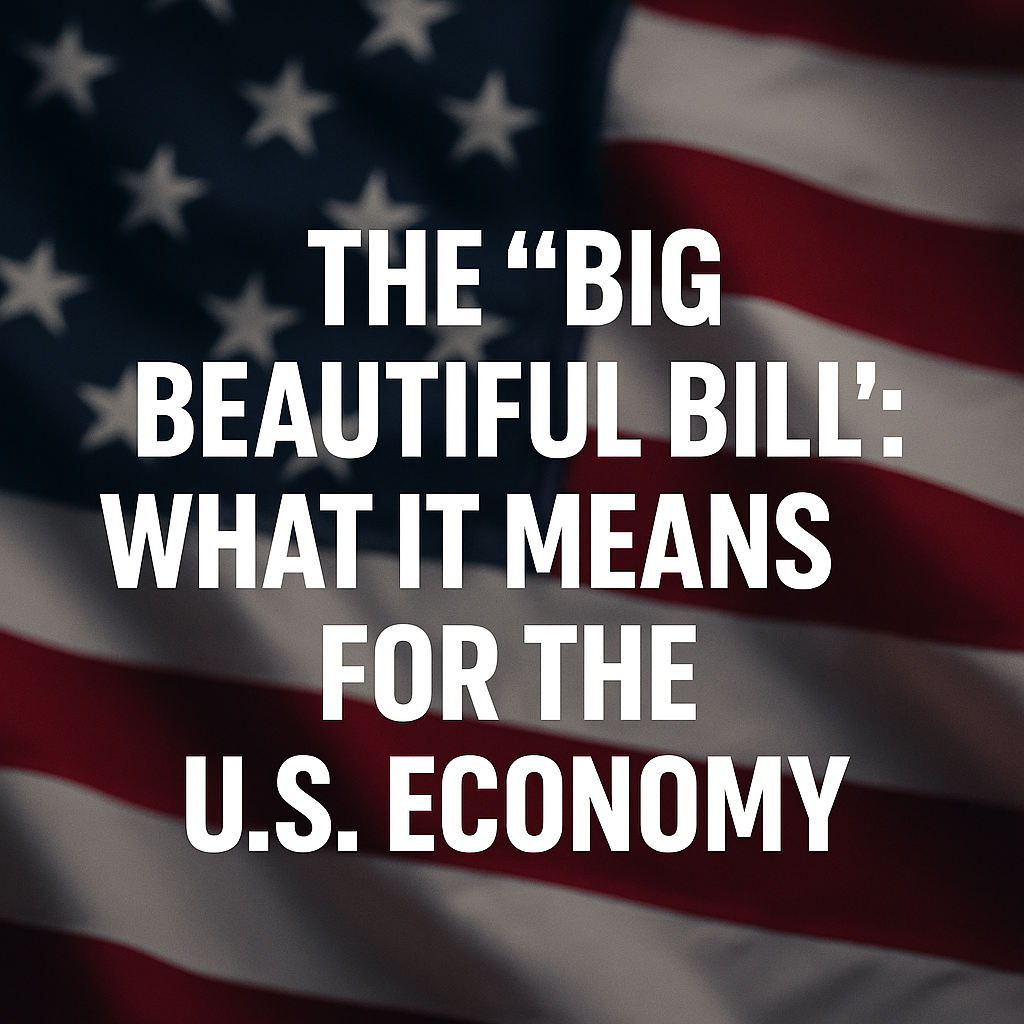🏛️ The “Big Beautiful Bill”: What Just Passed & Why It Matters for the U.S. Economy
1. What’s in the Bill?
-
Tax cuts & extensions: Permanently extends 2017 TCJA rates, new deductions for tips and overtime, boosted child tax credits ($2,200–$2,500 depending on phase).
-
SALT cap: House version raised to $40 k (for incomes up to $500 k); Senate might revert to $10 k.
-
New MAGA savings accounts: Up to $1,000 per child.
-
Defense & border funding: ~$150 b for military (including drones), $46 b+ for border infrastructure.
-
Cuts to safety nets: Stricter work requirements on SNAP/Medicaid, potentially affecting 10–11 m people.
-
Clean-energy rollbacks: Many Inflation Reduction Act credits trimmed/eliminated.
-
AI & regulatory limits: 10-year ban on state-level AI rules; rollback of environmental oversight.
2. Projected Economic Impacts
📈 Growth & Investment
-
Modest GDP boost: Tax Foundation projects +0.8% (House), +1.2% (Senate) in long-term GDP
-
Short-term business tax relief may spur some corporate investment—but Rice Institute warns long-term debt surges could offset gains.
🧾 Deficit & Debt
-
Big increase: CBO estimates $2.4 trillion added to national debt by 2034 (later raised to $2.8 t)
-
White House claims around $2.1–$2.3 trillion in deficit reduction through growth, though many assumptions are contested .
⚠️ Distributional Effects
-
Winners: Top 10% see income gains (~2–12 k annually); taxpayers in high-SALT states benefit most.
-
Losers: Bottom 10% lose ~3–4% of resources, lose access to SNAP and Medicaid.
3. Implications Going Forward
Pro-Growth Boost?
-
Small bump in GDP and investment—not a boom. Mixed academic estimates: 0.4–1.2% .
-
Temporary provisions (business deductions, tip/overtime breaks) create fiscal cliffs unless extended.
Rising Social Hardship
-
Safety-net cuts threaten food security, healthcare access, and may drive up medical debt and ER usage
-
Yale & UPenn estimate over 51,000 additional preventable deaths annually.
Fiscal Sustainability at Risk
-
Debt-to-GDP ratio projected to climb from ~98% to 122%.
-
Moody’s has already downgraded U.S. bonds, increasing future interest costs.
Political Fallout
-
Tax windfalls for the wealthy could deepen public backlash.
-
Regulatory rollbacks (AI, environment) fuel opposition from states and NGOs.
-
The divide: Republicans tout growth and sovereignty; Democrats warn of inequality and safety-net collapse.
4. What This Means for American Transformation
| Opportunity | Risk |
|---|---|
| Incentivizes work and investment via tax cuts | Exacerbates inequality and erodes the safety net |
| Military & border spending aligns with national security priorities | Deepens budget deficits and credit risk |
| SALT cap revision supports high-tax states | Leaves middle and lower-income households struggling |
| Promotes deregulation and streamlined government | Could undermine environmental and labor protections |
5. Key Takeaways for Forum Subscribers
-
Short-term growth is plausible—but it’s moderate, not transformative.
-
Social consequences will be real and likely severe in vulnerable communities.
-
Debt sustainability is a ticking time bomb—with rising interest costs and future fiscal constraints.
-
Policy cliffs loom: temporary breaks may expire, creating uncertainty.
-
Political stakes are high: framing this package as either “American revival” or “reverse Robin Hood” will shape its legacy.
✅ Final Thoughts
The “Big Beautiful Bill” stands as Donald Trump’s grand vision: bold tax relief, strengthened defense, and deregulation. However, the broader economic reality is more nuanced—a modest growth boost overshadowed by skyrocketing debt and social risk. For the American Transformation Forum, the conversation isn’t just about numbers—it’s about charting a sustainable path forward. Balancing growth with equity and fiscal discipline will define the next chapter of economic renewal.
Check out the GTF Research
Check out events
Connect with us on facebook
connect with us on linkedIn
Check out the American Transformation forum
